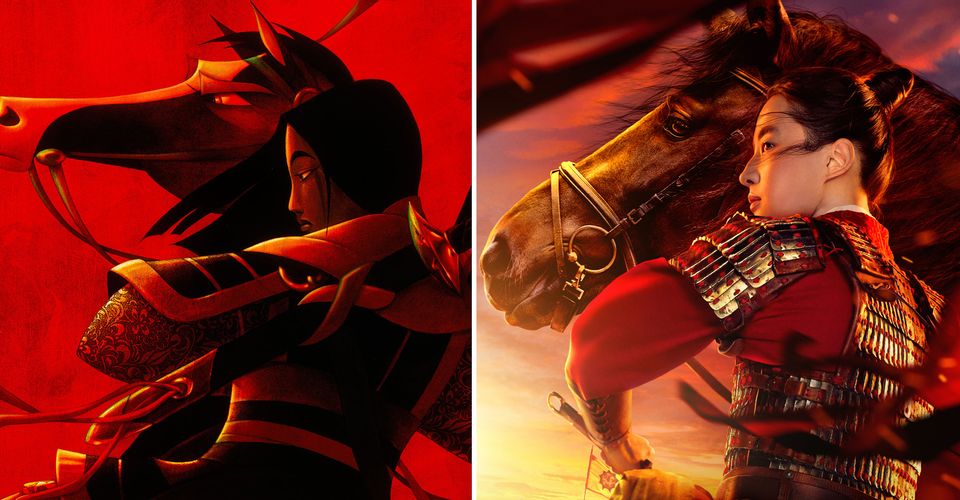Mulan (2020): 10 Big Changes They Made From The Original

After being listed as “in development” for nearly five years, the long-awaited live-action Mulan remake was finally released onto Disney+ in 2020. While Disney’s live-action remakes of animated properties have often been criticized for not being original or creative enough to justify their existence, the new Mulan film can at least say it changes a lot from its predecessor.
Whether these changes were for better or for worse is ultimately up to the audience to decide, as some may have too much nostalgia for the original to accept a modern version, while others might appreciate the various updates made by the remake’s crew.
10 PG-13 Rating

2020’s Mulan is a darker, more violent retelling of its centuries-old source material than the 1998 Disney classic. Because of this, it’s the first ever live-action adaptation of a Disney property to earn a PG-13 rating.
This most likely won’t stop families from checking it out (after all, eight out of the ten highest-grossing films of all time are rated PG-13), but it does represent a significant change between the new Mulan and its predecessor.
9 All-Asian Cast

While the original Mulan cast several non-East Asian voice actors in Asian roles (such as June Foray as Grandmother Fa), the new version boasts an all-Asian cast.
A live-action Mulan not being whitewashed was obviously very important to fans of the original, and it’s good to see that Disney decided to maximize Asian representation as soon as they began work on the $200-million remake.
8 The Addition Of Chi

While the original Mulan‘s only source of spirituality is the watchful ancestors (who it could be said appear solely for comedic purposes), the new version adds a new layer of mysticism with its inclusion of Chi. Chi is a concept in Chinese culture relating to the energy or “life force” found in every human being, and how it can be harnessed and materialized.
2020 Mulan is shown to be a master of chi gung (the art of controlling Chi), which is explained as the reason for her advanced martial arts skills.
7 The Villains Are Different

The Mulan remake changes the original film’s villains, the Huns, into the Rourans, making it more accurate to the original Ballad of Mulan.
On top of that, a new villain is added: shapeshifting witch Xian Lang, who is a sort of anti-Mulan as they share common attributes (both having to prove themselves as women in armies led by men) but have completely different virtues.
6 Li Shang Is Replaced With A New Love Interest

As a direct result of the #MeToo movement, the crew behind 2020’s Mulan removed the original’s Li Shang, deciding that “having a commanding officer” as Mulan’s love interest wouldn’t sit well in the current climate.
RELATED: Disney: 10 Things That Don’t Make Sense About Mulan
This briefly caused a stir amongst fans of the original due to Li Shang’s status as a posited bi icon, but, at the very least, Disney did add two new characters to fill his duel roles as leader and love interest: Commander Tung and Chen Honghui, respectively.
5 Several Characters Have Been Removed Entirely

Li Shang was at least represented in the Mulan remake, but several characters from the original were completely scrapped.
Most notable of them is Mushu, the talking dragon voiced by Eddie Murphy, but other characters such as Grandmother Fa, the ancestors (who are mentioned, but not seen), and Shan Yu are gone, as well.
4 Mulan Reveals That She’s Female

This is a point at which both the 1998 and 2020 versions of Mulan differ from their source material: in The Ballad of Mulan, Mulan serves 12 years in the army before returning home with her comrades still believing her to be male. Meanwhile, in the 1998 film, she’s found out after being wounded in combat.
The 2020 film, however, has Mulan admit her deception to Commander Tung, holding closely to the “loyal, brave, true” virtues the story promotes.
3 Mulan Has A Sister

The new version of Mulan was given a younger sister, largely because the filmmakers wanted to add an extra incentive for her to join the army.
It may seem a pointless addition, but it’s possible that the change was inspired by the plot of the 1600s historical fiction novel Romance of Sui and Tang, one of the best-known works containing the character of Mulan, which also features a younger sister character.
2 Mulan Doesn’t Cut Her Hair

Aside from the character of Mushu, one of the things Chinese audiences found the most issue with in Disney’s original Mulan was the iconic scene in which she cuts her hair to look more like a boy.
This is because Chinese soldiers were actually known to have long hair, so if anything, cutting her hair would get Mulan outed faster. On account of this, the crew behind the new version made the decision to remove the hair-cutting scene completely.
1 None Of The Original Songs Are Included

Perhaps the most shocking exclusion from the new Mulan is the original’s songs, if only because it differs in this respect from nearly every prior live-action Disney remake.
It’s worth noting that the 1998 film’s songs aren’t completely eliminated from the 2020 version, due to instrumental homages in the soundtrack and veiled references in the screenplay, but given that the music was one of the most memorable parts of the original, its exclusion is drastic.
About The Author

















